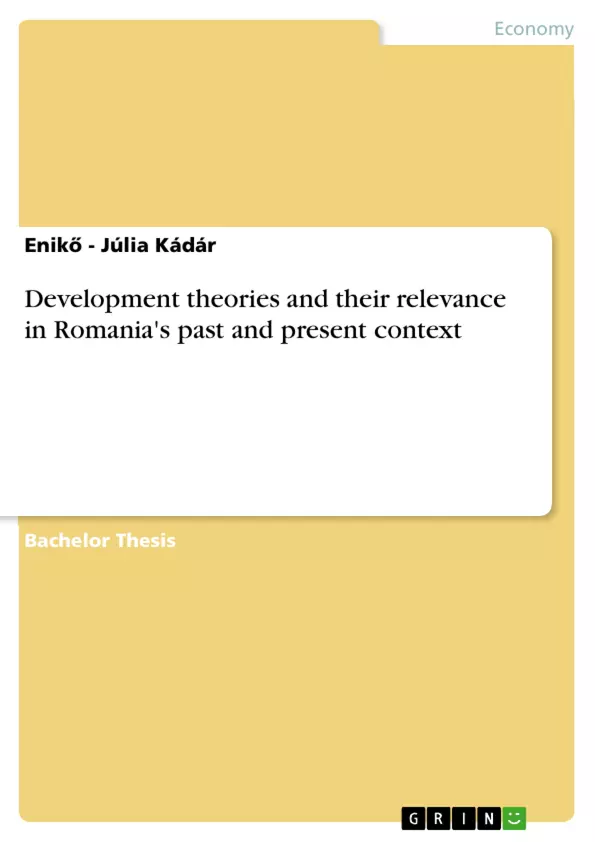Although Romania is considered one of the fastest growing economies with favourable prospects for the future, the country is lagging far behind other European countries on issues such as the quality of healthcare and education systems, levels of corruption, macroeconomic stability, and environmental safety.
The aim of this thesis is to provide an ensemble view of the factors that actually determine how advanced a country is by analysing the main Development Theories provided in the literature, and determining their significance in Romania’s past and present context.
This is done by first presenting each theory in detail, to ensure an understanding of the various dimensions and factors that should be taken into account in the assessment of any nation’s level of development, followed by an examination – tailored specifically to Romania’s context – of the four domains of sustainable development (economics, politics, society & culture, and ecology) through the consolidation of relevant statistical data and bibliographical information.
The findings of the paper highlight the fact that Romania’s overall development is not equivalent to its economic growth, as the latter does not necessarily reflect the population’s welfare. For the country to be considered advanced from other points of view as well, authorities should not fail to recognize that attracting and retaining foreign investment, encouraging entrepreneurship, increasing the national budgets for education, health-care, and infrastructure improvement, tackling the serious, ongoing problem of corruption and lack of institutional transparency, and strengthening environmental awareness and independence are all factors that have an important role in defining Romania’s current level of development, and in providing future generations with further opportunities.
Inhaltsverzeichnis (Table of Contents)
- Introduction
- Chapter I. Development Theories
- I.1. Stages of Growth Model of Development
- I.2. Structural Change Theories
- I.3. International Dependence Theories
- I.4. Liberal Theories
- I.5. Exogeneous Growth Model
- I.6. Human Development Approach
- I.7. Development and Sustainability
- Chapter II. Romania on the Spectrum of Development
- 2.1. Applied Approaches
- 2.2. Economics
- 2.3. Politics
- 2.4. Society & Culture
- 2.5. Ecology
- Chapter III. Conclusion & Proposals
Zielsetzung und Themenschwerpunkte (Objectives and Key Themes)
This thesis aims to examine the key factors that influence a country's level of development by analyzing various Development Theories and applying them to Romania's past and present context. It focuses on how these theories have shaped the country's economic, political, social, cultural, and ecological progress. The objective is to determine Romania's current development status and identify significant trends that influence its advancement.
- Development Theories and their applicability to Romania
- The role of economic growth in overall development
- The impact of political, social, and cultural factors on development
- The importance of sustainable development in Romania's context
- Factors crucial for Romania's future development
Zusammenfassung der Kapitel (Chapter Summaries)
Chapter I provides an overview of the six main Development Theories presented in the literature. This chapter analyzes each theory in detail, including the Stages of Growth Model, Structural Change Theories, International Dependence Theories, Liberal Theories, the Exogeneous Growth Model, and the Human Development Approach. It also examines the concept of sustainable development, emphasizing its importance in achieving balanced national progress.
Chapter II delves into a comprehensive analysis of Romania's development status, applying the Development Theories from Chapter I to the country's context. The chapter examines the economic, political, socio-cultural, and ecological domains of sustainable development, analyzing Romania's progress and challenges in each area. It considers various statistical data and bibliographical information to provide a nuanced understanding of Romania's position on the development spectrum.
Schlüsselwörter (Keywords)
The thesis focuses on key concepts like Development Theories, Romania's development, sustainable development, economic growth, political systems, social and cultural factors, environmental sustainability, and the influence of foreign investment and entrepreneurship on national progress.
- Quote paper
- Enikő - Júlia Kádár (Author), 2018, Development theories and their relevance in Romania's past and present context, Munich, GRIN Verlag, https://www.grin.com/document/459733



